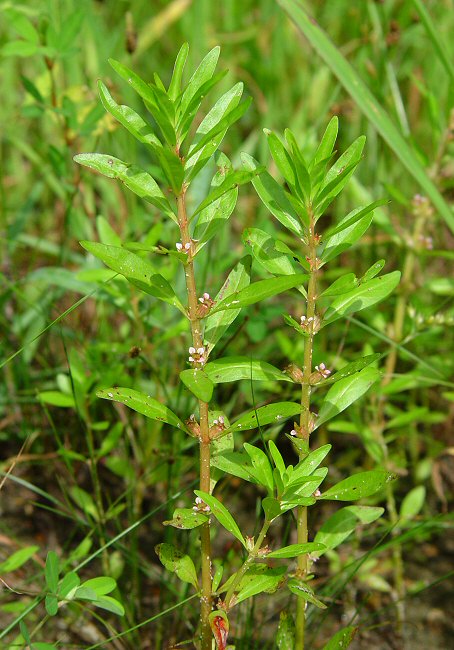Rotala ramosior (L.) Koehne
Toothcup

Native
CC = 4
CW = -5
MOC = 68
© DETenaglia
Rotala ramosior (L.) KoehneToothcup | |
 |
Native CC = 4 CW = -5 MOC = 68 |
© DETenaglia |
|
Family - Lythraceae Habit - Fibrous-rooted annual forb, terrestrial or strongly emergent aquatic, not producing basal offsets. Stems - Strongly ascending to erect, to 40 cm, sometimes rooting at the lower nodes, strongly 4-angled, often branched from near the base, the branches spreading to arched upward, green but becoming red in strong sun, glabrous.
Leaves - Opposite, simple, decussate, sessile, not flared at the base, glabrous. Leaf blades 1-5 cm long, 2-12 mm wide, linear to narrowly lanceolate or oblanceolate, the largest leaves always 3 mm or wider, narrowed or tapered to a usually sharply pointed tip, the lower leaves truncate to more commonly auriculate-cordate at the base, the upper and often also median leaves tapered at the base.
Inflorescences - Solitary sessile flower from each leaf axil, subtended by a pair of opposite minute bracts. Bracts to 3 mm long, 1 mm broad, glabrous.
Flowers - Actinomorphic, the hypanthium about as long as wide, cup-shaped, sometimes becoming nearly globose at fruiting, symmetric at the base (not pouched or spurred), not oblique at the tip, the hypanthium plus sepals 2-5 mm long, with 4 or 8 longitudinal ridges, these most fully developed at fruiting. Sepals 4, triangular to broadly triangular, the appendages about as long as the sepals, thickened, triangular. Petals 4, 1-2 mm long, orbicular, usually light pink, alternating with the calyx appendages. Stamens 4, those of different flowers with filaments the same length, the anthers not exserted, light yellow. Pistils lacking a nectary disc, the ovary superior, globose to subglobose, incompletely 3-or 4-locular, the style relatively long and exserted. Placentation axile. Ovules numerous.
Fruits - Globose capsules 3-5 mm in diameter, dehiscing longitudinally along 3 or 4 of the partitions between locules, the outer wall with fine transverse lines (best observed with magnification). Seeds numerous, 0.4-0.8 mm long, asymmetrically ovoid (1 side concave, the other convex), the surface with a network of fine, sometimes faint ridges, yellow to reddish brown.
Flowering - June - October. Habitat - Streambanks, pond margins, swamps, sloughs, marshes, saline springs, ditches, fields, open disturbed areas. Origin - Native to the U.S. Lookalikes - Species of Ammannia. Other info. - This small but attractive species can be found in the southern 2/3 of Missouri. Beyond Missouri it ranges throughout most of the eastern half of the continental U.S., and is also found (somewhat uncommonly) in west coast states. The plant is easy to identify from its habitat, slender opposite leaves which are tapered at the base, and its tiny, 4-petaled pink flowers. It closely resembles species of Ammannia, but those plants have leaves which flare at the base. Photographs taken in the Ozark Scenic Riverways, Shannon County, MO., 7-28-04, and off Lee Rd. 27, Auburn, AL., 9-15-05 (DETenaglia); also at Catawissa Conservation Area, Franklin County, MO, 9-10-2017; and Duck Creek Conservation Area, 8-20-2024 (SRTurner). |